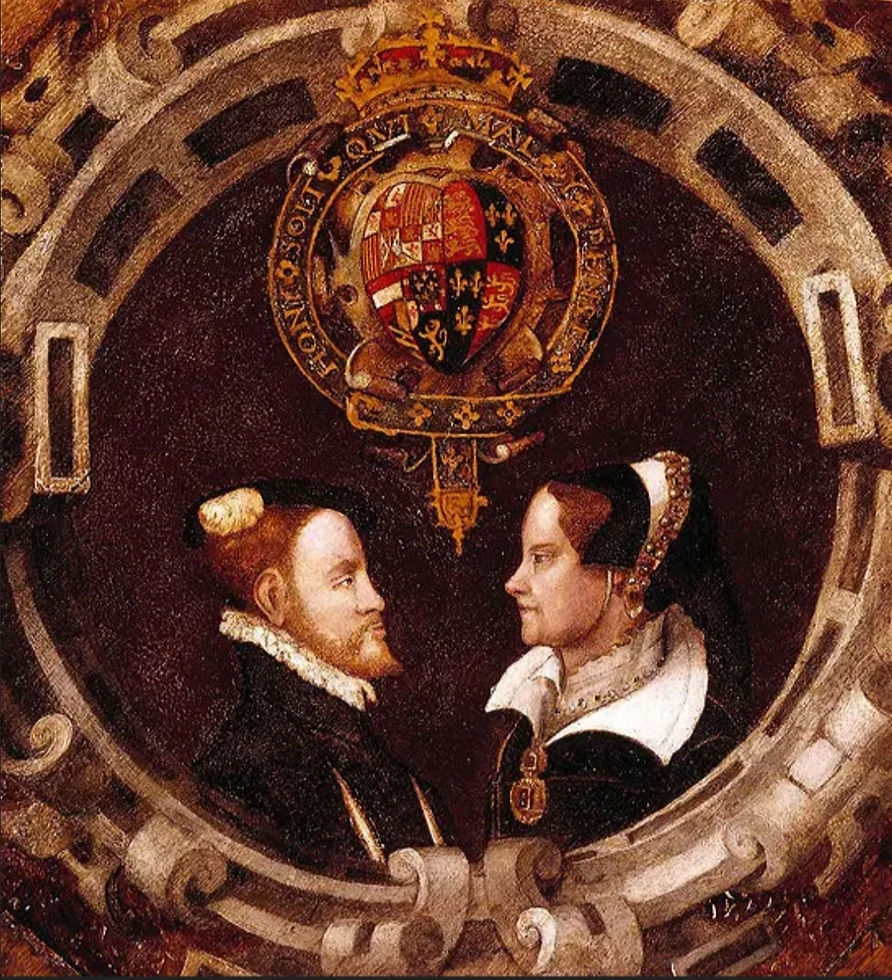
Queen and Bishop - a powerful combination
- gilldavid560
- Jul 24
- 4 min read
Stephen Gardiner - a roller-coaster life Part 2
... this marriage and alliance, which renders me happier than I can say, as I daily discover in the king, my husband and your son, so many virtues and perfections that I constantly pray God to grant me grace to please him and behave in all things as befits one who is so deeply embounden to him…
Letter from Queen Mary l to her father-in-law, Emperor Charles V
Admittedly, she loved hunting on horseback, with ample opportunities here in Farnham, and a gift of greyhounds and a hawk were made to her during her three week stay. But why did Mary l choose to stay in the Bishop's Palace in Farnham for the best part of three weeks on the eve of her marriage? There is more to her decision than mere recreation. Mary's perilous situation may help us understand why she chose to find peace and security in the home of Bishop Stephen Gardiner, her most trusted servant and adviser.
The background - Mary's position had been in jeopardy from the moment she became queen on the death of her half brother, Edward VI, in July 1553. Mary was a devout Catholic, determined to return England to the ‘true faith’, and this placed her under suspicion and put her life in danger. Within a matter of weeks her succession to the throne was under threat. There was a plan to depose her and replace her with her half-sister Elizabeth and, of course, every school pupil will have heard of the plot to make Lady Jane Grey queen instead of Mary.
Mary chooses a husband
Aged 37, and after a sad and tumultuous life, Mary finally felt she had a chance of happiness, not least in her personal life. She had selected a future husband to help secure the dynasty, Philip of Spain, who was a kinsman, well-read, but, most importantly, a Roman Catholic who could help her restore England to Catholicism. But, her choice of husband was not universally popular in England.
Parliament tried to dissuade Mary from marrying Philip, but the lady was ‘not for turning’. Bishop Stephen Gardiner, one of the most important prelates in the realm, and also her Lord Chancellor, worked long hours to produce an agreement that would allay fears of England having a foreign king. He negotiated a treaty and marriage contract in which it was clear that Philip would never be permitted to interfere in England’s government, nor to draw England into Spain’s wars.
Wyatt's Rebellion
Nevertheless, Mary's opponents resolved that a military coup would be the only way to prevent her marriage. The stage was set for Wyatt's Rebellion, orchestrated by a group of nobles, which put the new queen's authority and popularity to the test. The plan was to stage three separate uprisings in the West Country, the Midlands and Kent. However, Bishop Stephen Gardiner was made aware of the plot some weeks ahead, so much of the element of surprise was lost. After some initial successes, by the time the rebels reached London on 3rd February 1554, Mary had rallied her troops with a rousing speech, and Wyatt found the City guarded and barricaded on the orders of Stephen Gardiner. The Queen and the Bishop had checkmated their enemy!
Wyatt was tried at Westminster Hall on the 15th March. He was found guilty of treason and was executed on the 11th April 1554. He was beheaded and then his body was quartered and his bowels and genitals burned. His head and the quarters of his body were then taken to Newgate where they were parboiled, nailed up and the head placed on a gibbet at St James's.
Mary's Marriage
Fast forward to Sunday, July 25 1554 when Bishop Stephen Gardiner officiated at Mary and Philip’s wedding in Winchester Cathedral. The bride was 37, the groom 26; a happier occasion for Mary than Philip, who was already a widower. She modelled the lavish wedding ceremony on that of her mother, Catherine of Aragon, when she had wed Prince Arthur Tudor, in 1501.
Philip, although outwardly attentive to his new wife, didn't find her attractive and he spent increasing amounts of time absent from her side. On the 17th November 1558 when Mary died, Philip was abroad, dealing with the death of his father. Upon Mary’s death, Philip lost his title of King of England and Ireland and had no claim to the English throne. On hearing of the death of his wife, he told his sister: “I felt a reasonable regret for her death. I shall miss her.”
Farnham - a port in a storm?
Mary's reign was relatively short and its legacy of martyrdom and bloodshed are well known. Like so many women of royal lineage, her life had never been her own. She was a pawn in the marriage stakes, and the product of what might be termed today a most 'dysfunctional' family. Perhaps she found some peace and solace in her sojourn in Farnham in June 1554. After all, Gardner himself often chose to escape to Farnham since in his palace at Southwark, he often contended with pestilence and diseases such as the sweating sickness.
Farnham has always been a Convenient Place



Comments